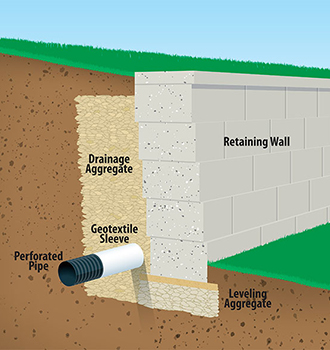I advocate just putting non woven geotextile fabric and 3 4 stone behind the wall so the water will migrate down with gravity and eliminate hydrostatic pressure on the wall.
Perforated drain pipe retaining wall.
Steven baczek a residential architect from reading mass who specializes in designing durable low energy homes responds.
Having a perforated drain behind a retaining wall makes no sense as the water will exit as quickly as it enters through the perforations.
Learning how to build a retaining wall can be fun with these helpful tips.
Perforated drains allow the water to flow out of the wall preventing it from collapsing under the weight of too much water.
Hi i m building a retaining wall in my garden a need to put a drain at the foot of the wall.
This should be a perforated pipe to allow water to enter it through the length of the wall.
Some of these drains are vented through the front of the retaining wall while others may run the length of the wall and drain out to the sides.
Retaining walls with a height greater than a few feet should also have weep holes that are regularly spaced in the vertical direction forming a grid pattern.
Backfilling the space behind the blocks with crushed stone and then installing a flexible perforated drainpipe available at the home depot also called drain tile at the base of the wall.
Drain pipes used in toe drain applications must be properly vented a minimum of every 50 ft.
This video shows you how to properly install a drainpipe behind your wall for prop.
1 2 m tall will require a toe drain.
No perforated drain pipe.
I hear arguments for both methods but it really depends on how the pipe functions in your drainage system before going any further the pipe we are discussing here is heavy duty.
Mar 19 2014 when building a retaining wall lay perforated drainage tubing at the base of the wall slightly above ground level so runoff can drain out without undermining your wall.
Retaining wall leaking drainage rocks.
Pipe drains also known as toe drains are perforated pipes that collect water along the length of the wall and drain it to the outside.
Sites with poor draining soils or walls over 4 ft.
When i use perforated pipe in a drainage system should the holes go up or down.
Another method for relieving hydrostatic pressure is to install a drainage pipe behind the wall.
I was going to use a perforated 100mm flexible pipe in a geo textile sleeve bedded in gravel but i can t find a product that would allow me to t off smaller diameter weep holes at regular intervals what can i use without spending the earth or should i just bing the pipe out of the wall at one.





























